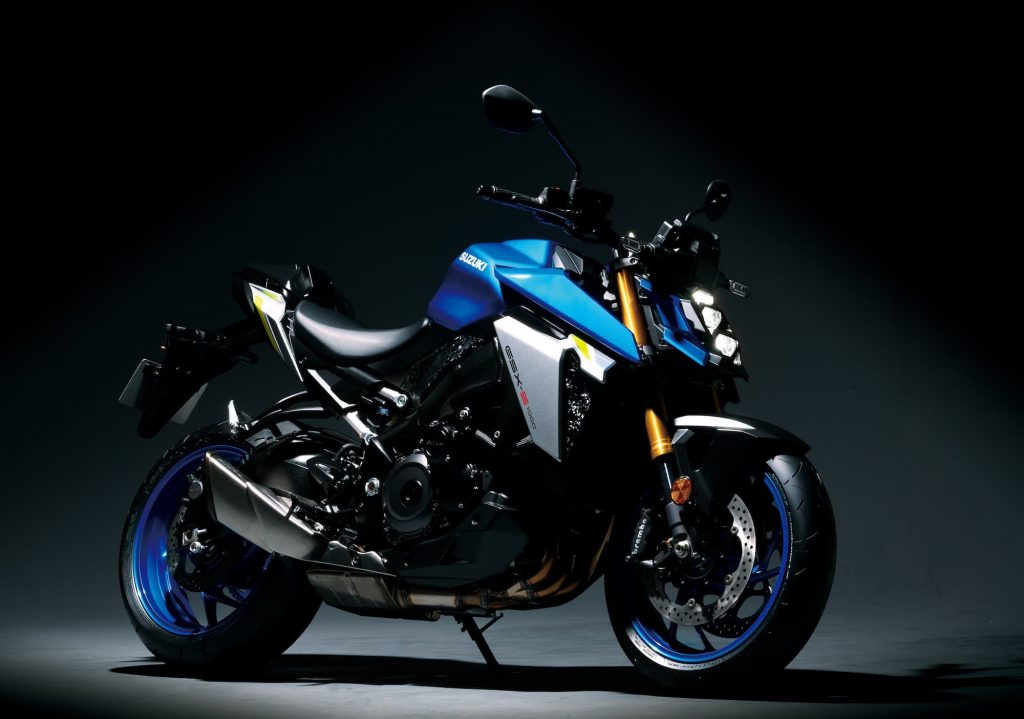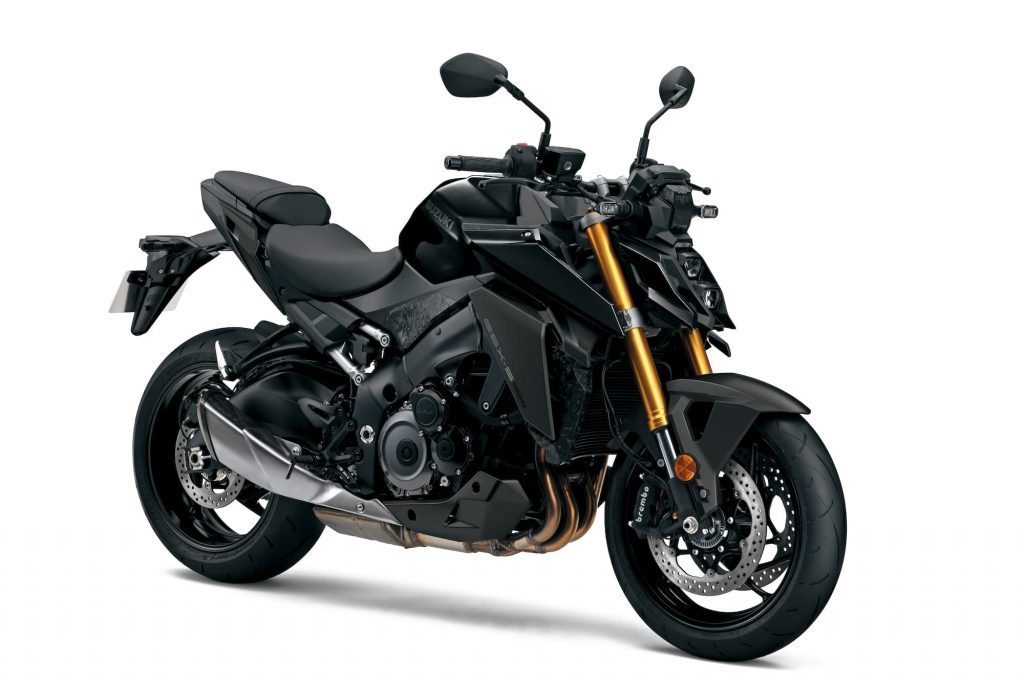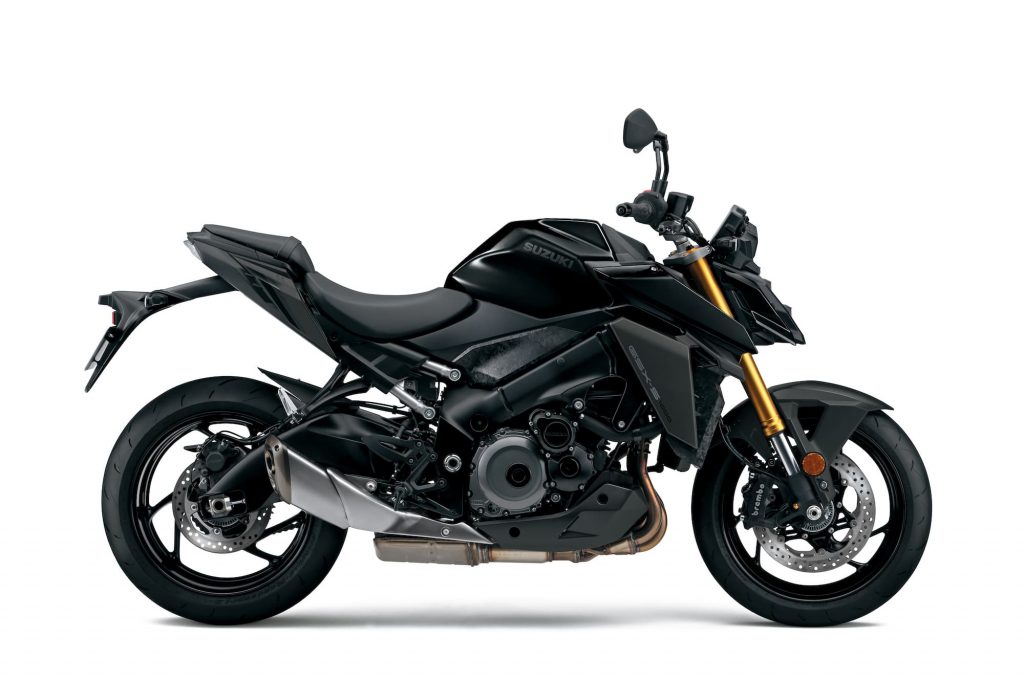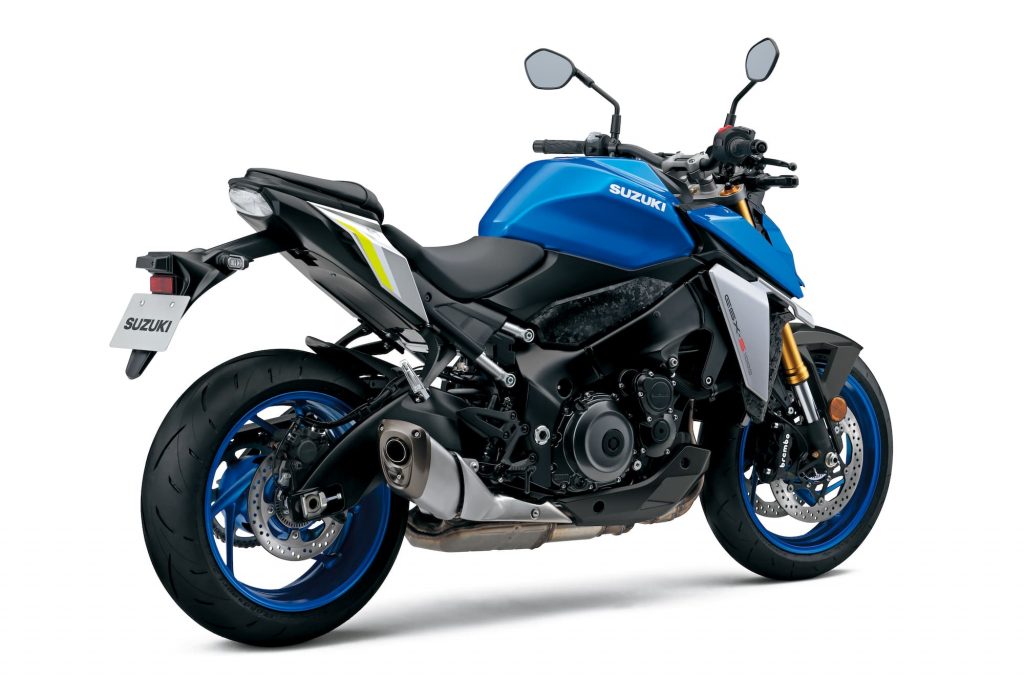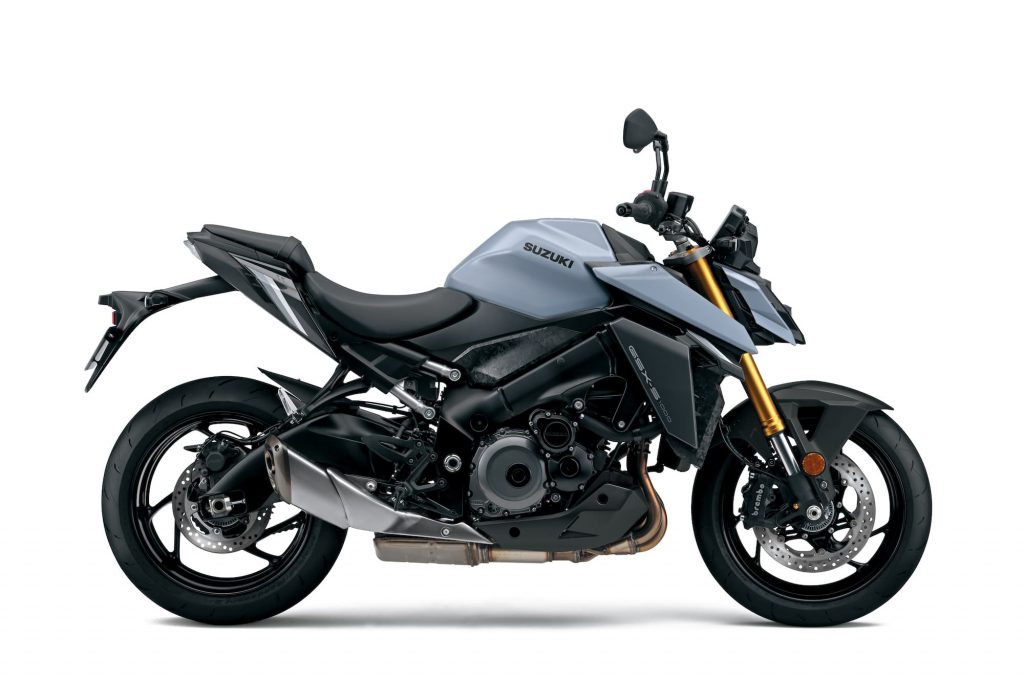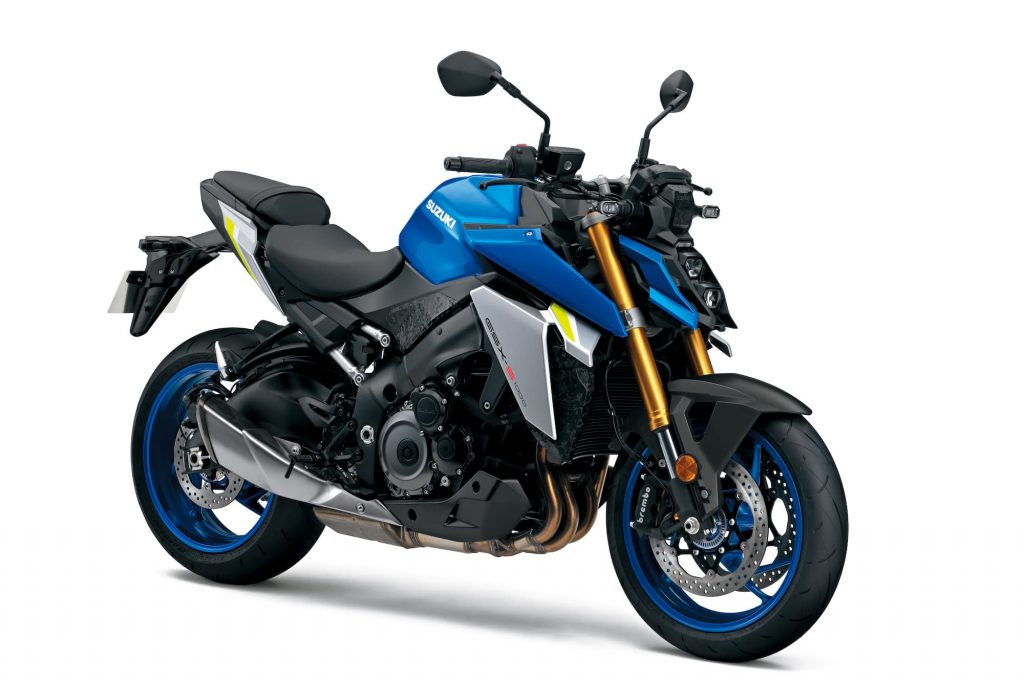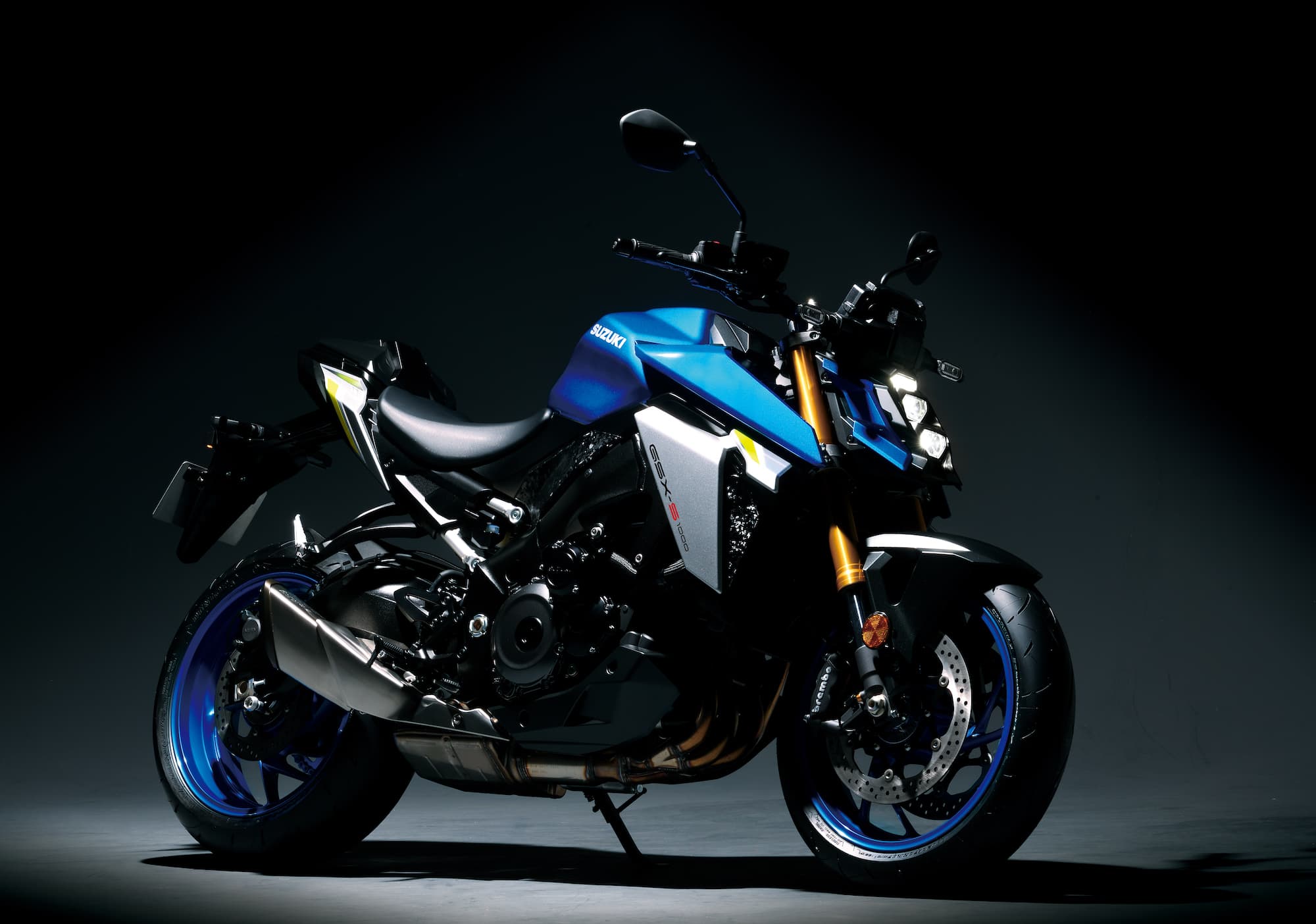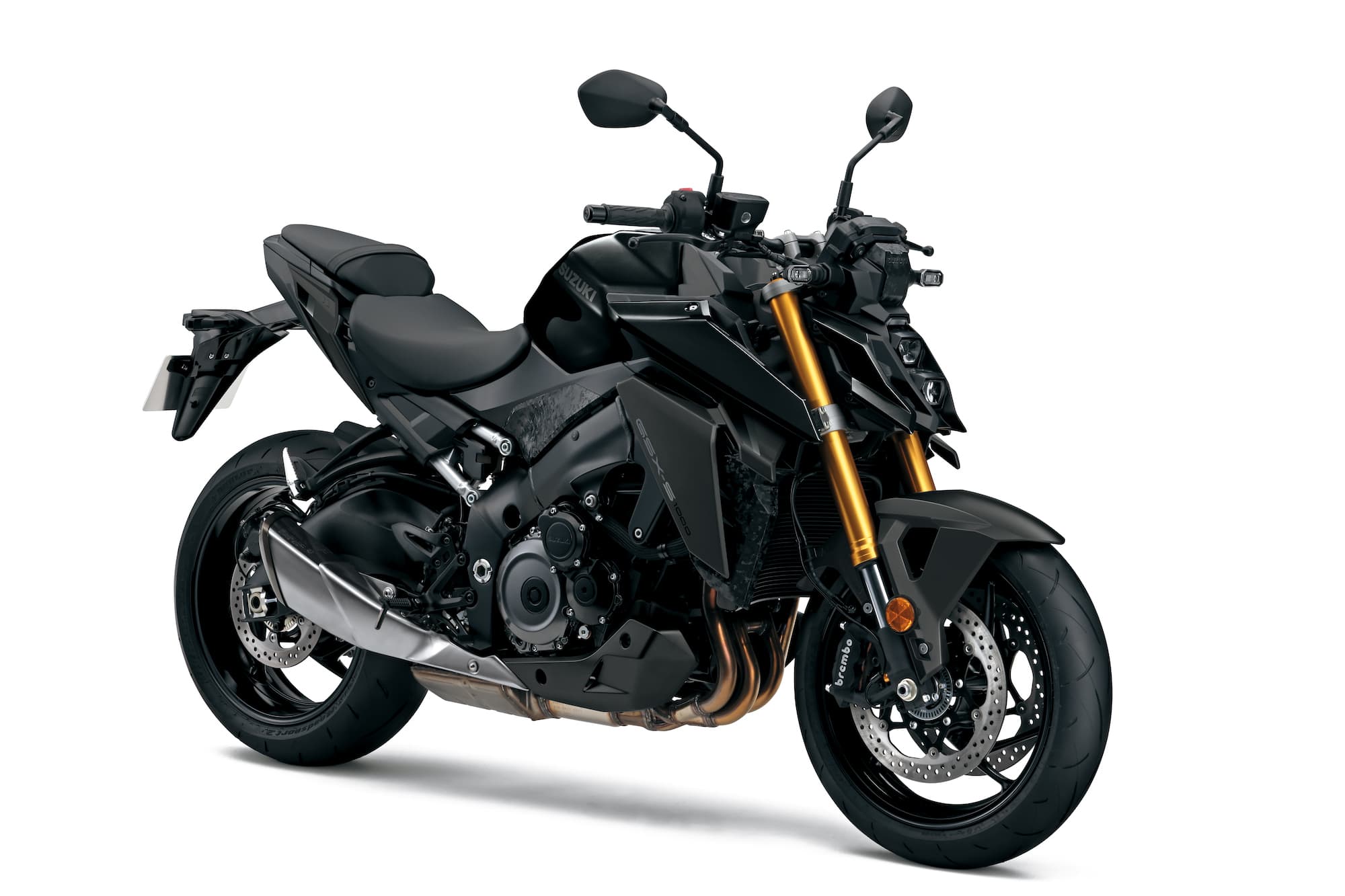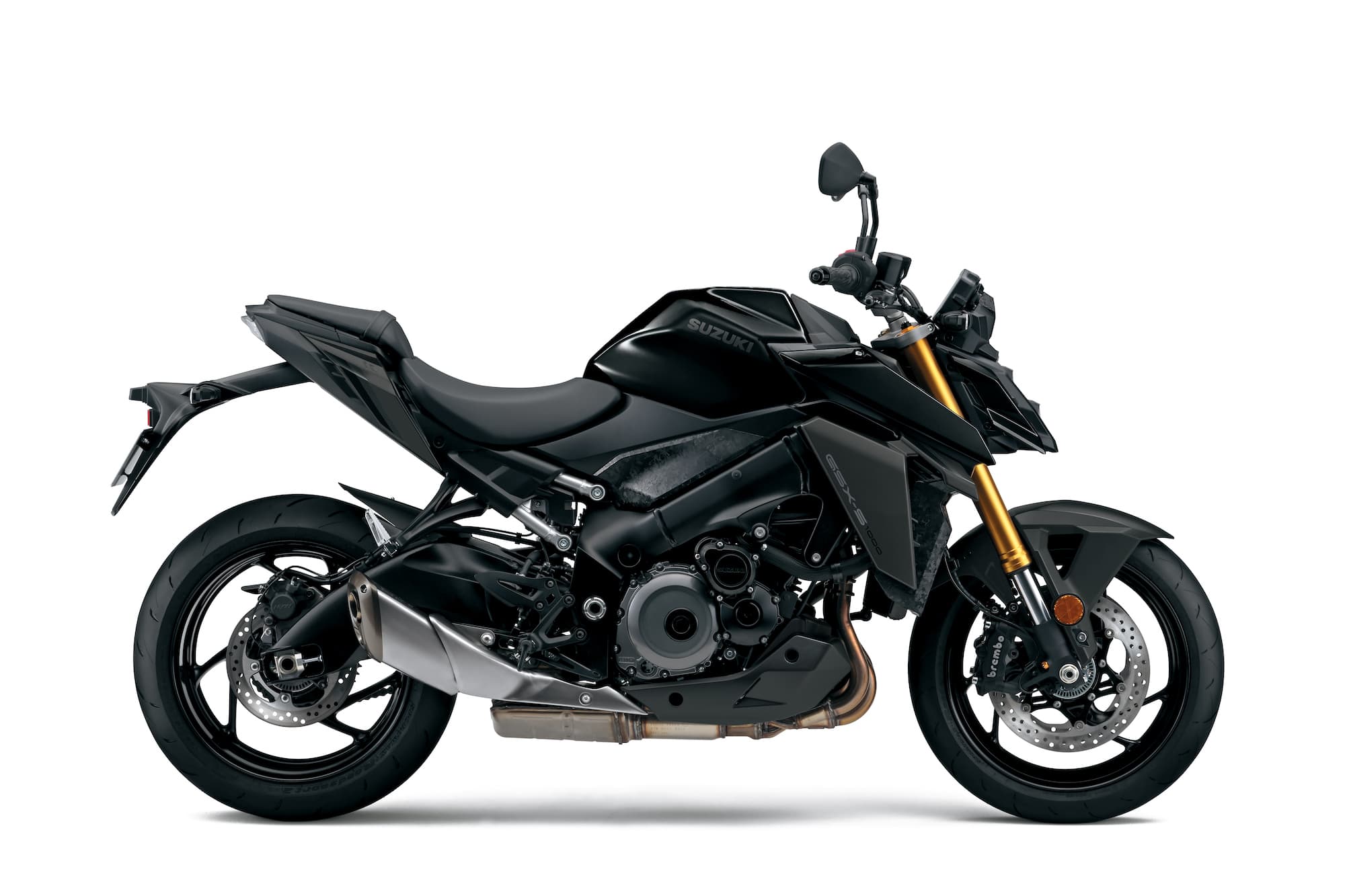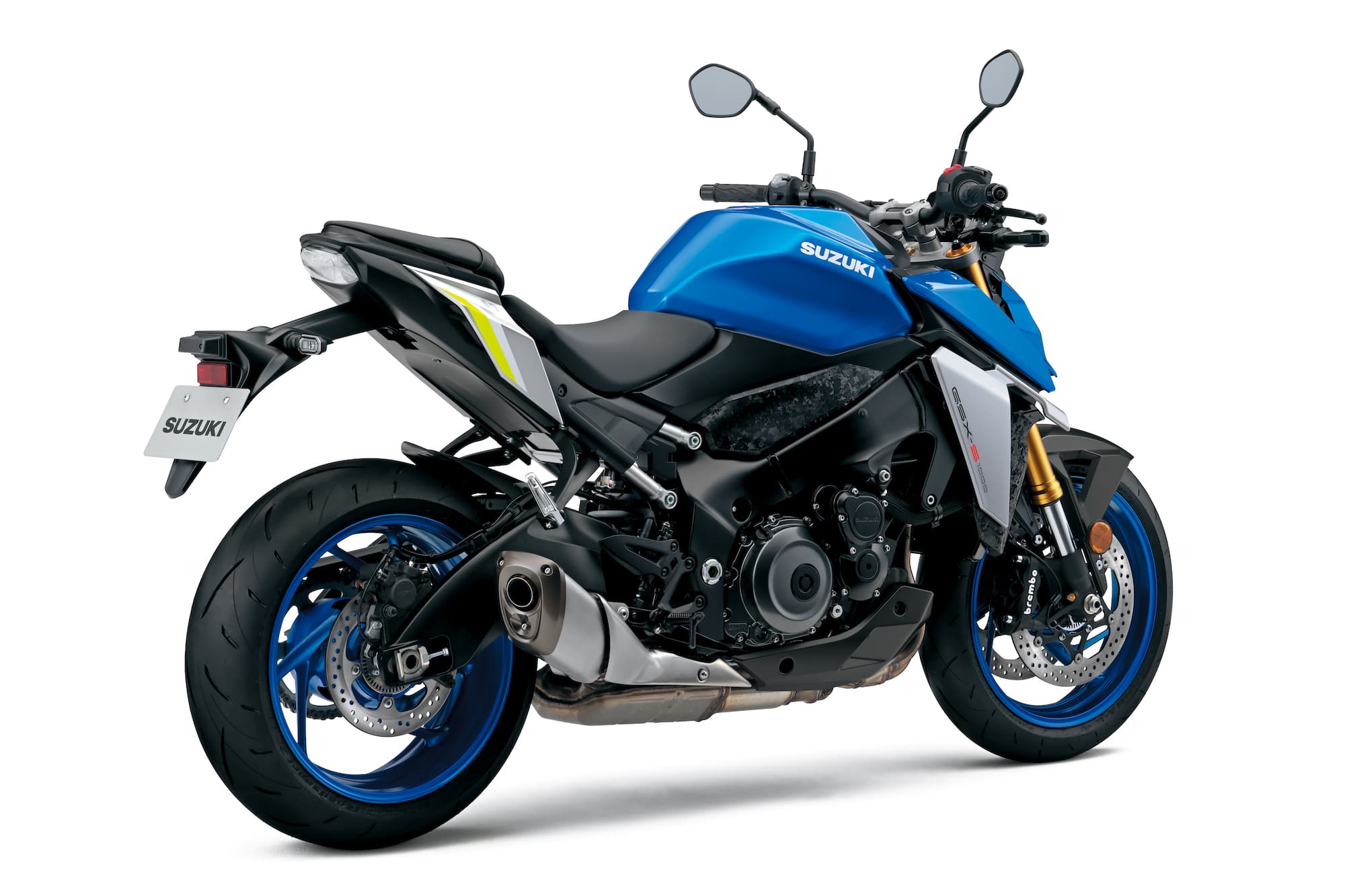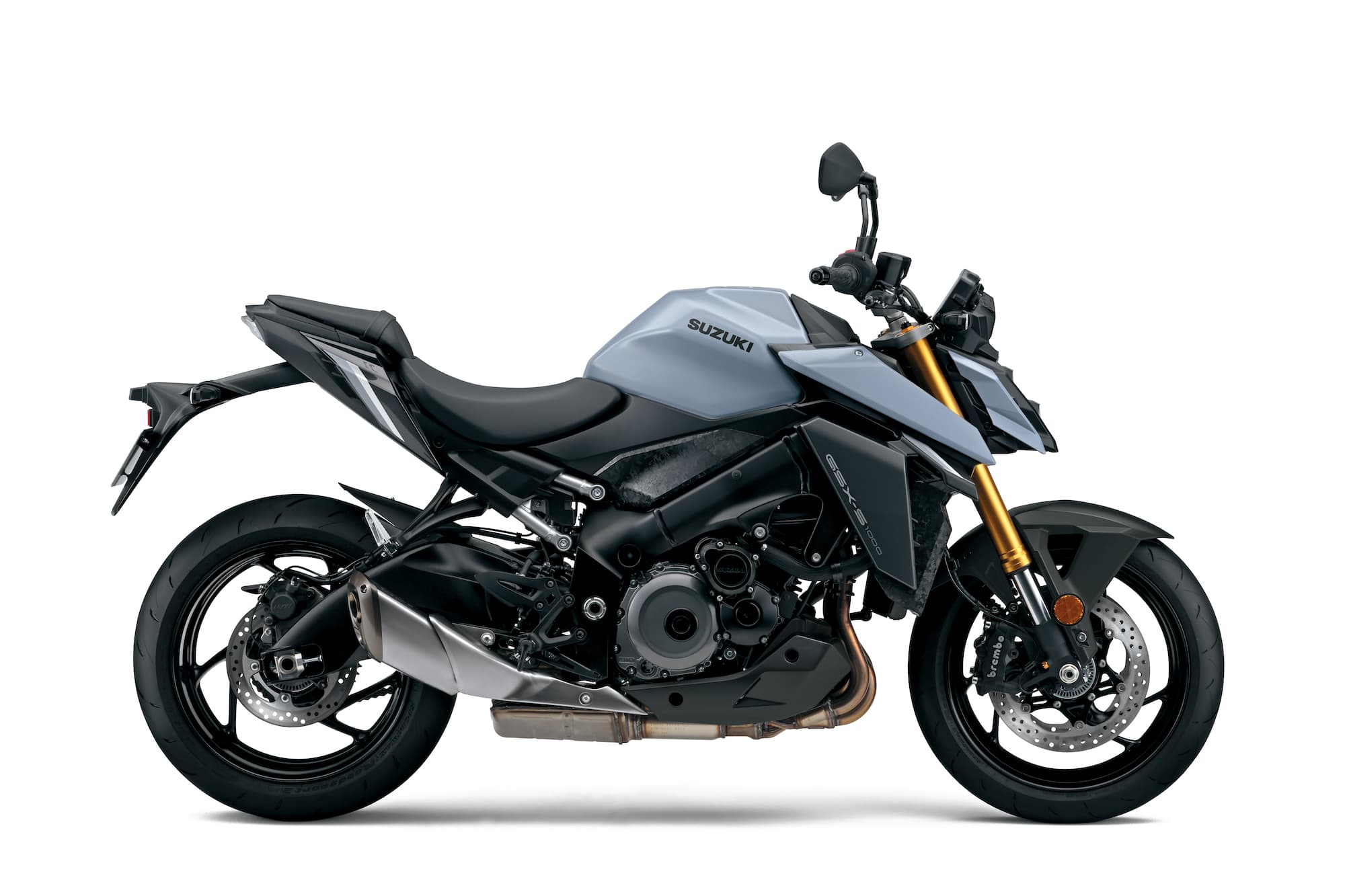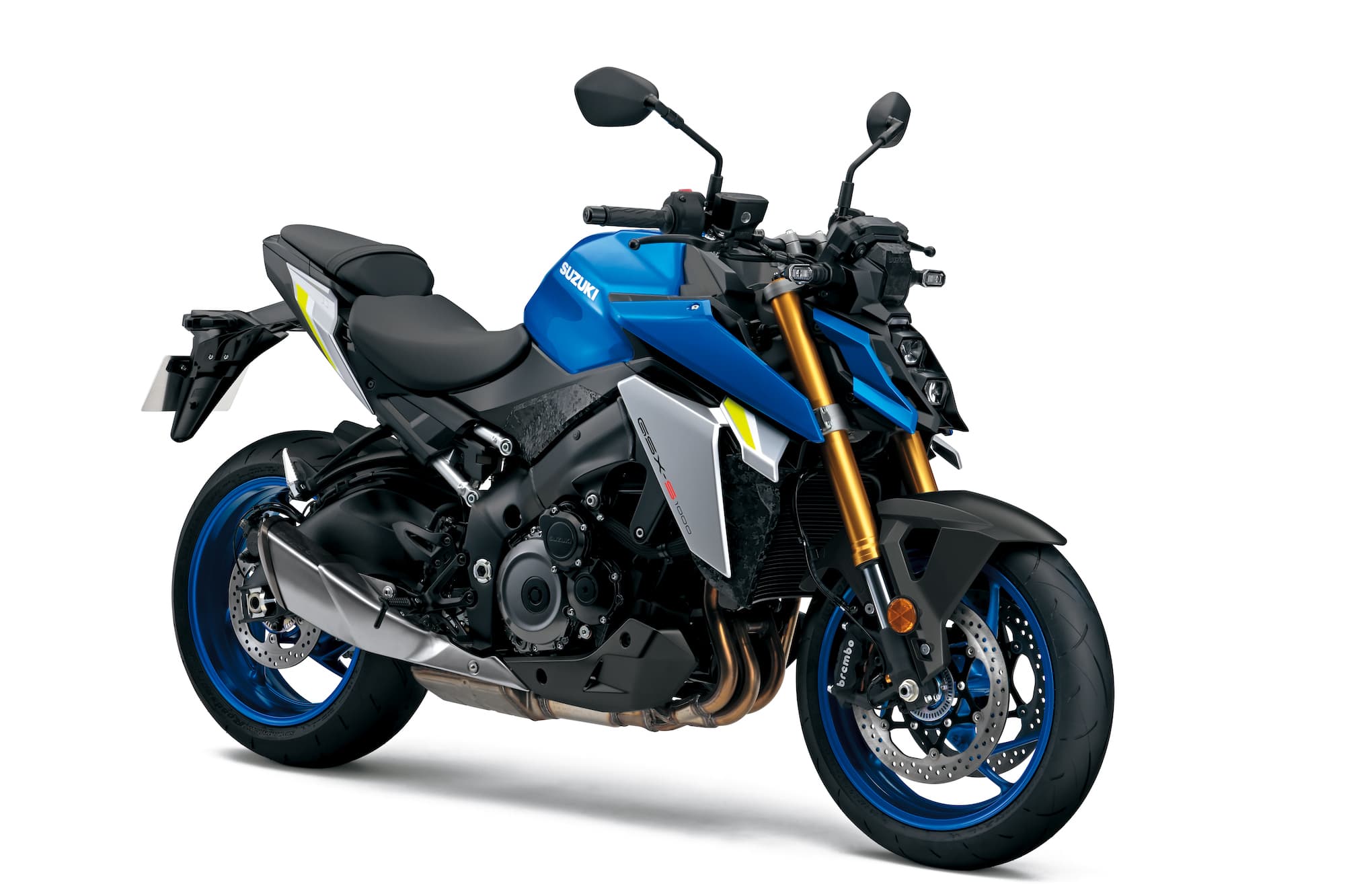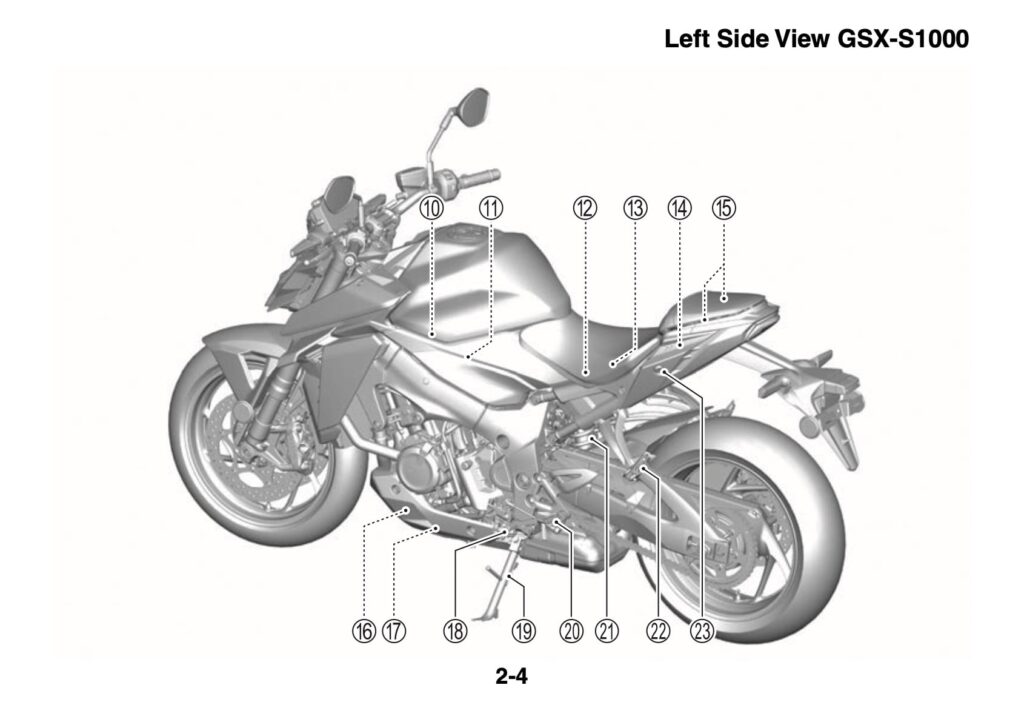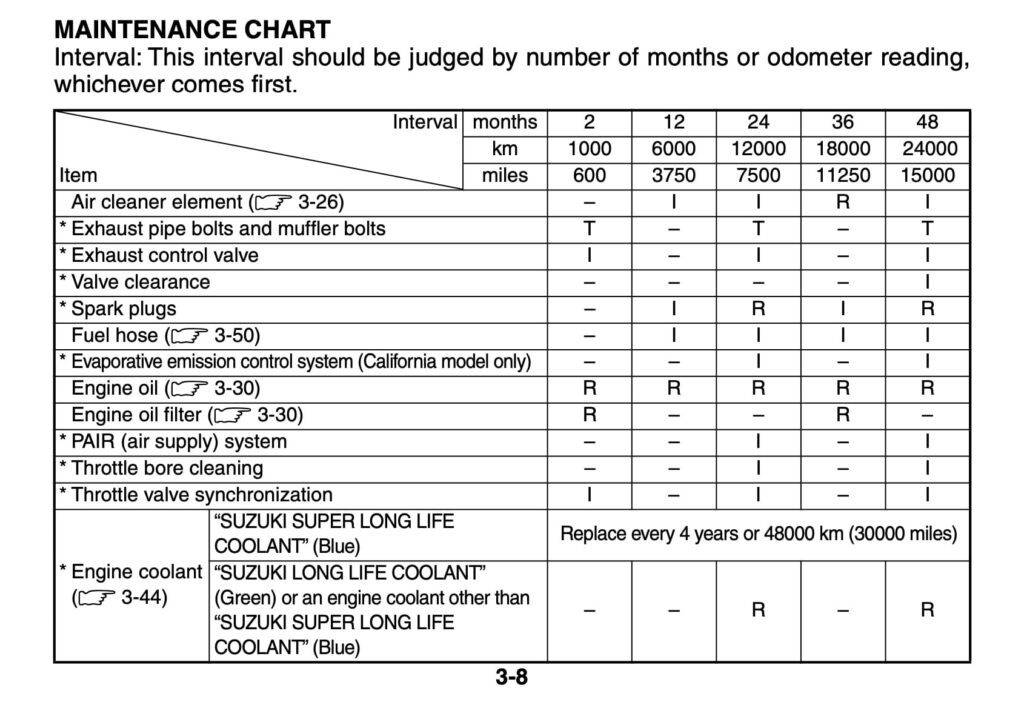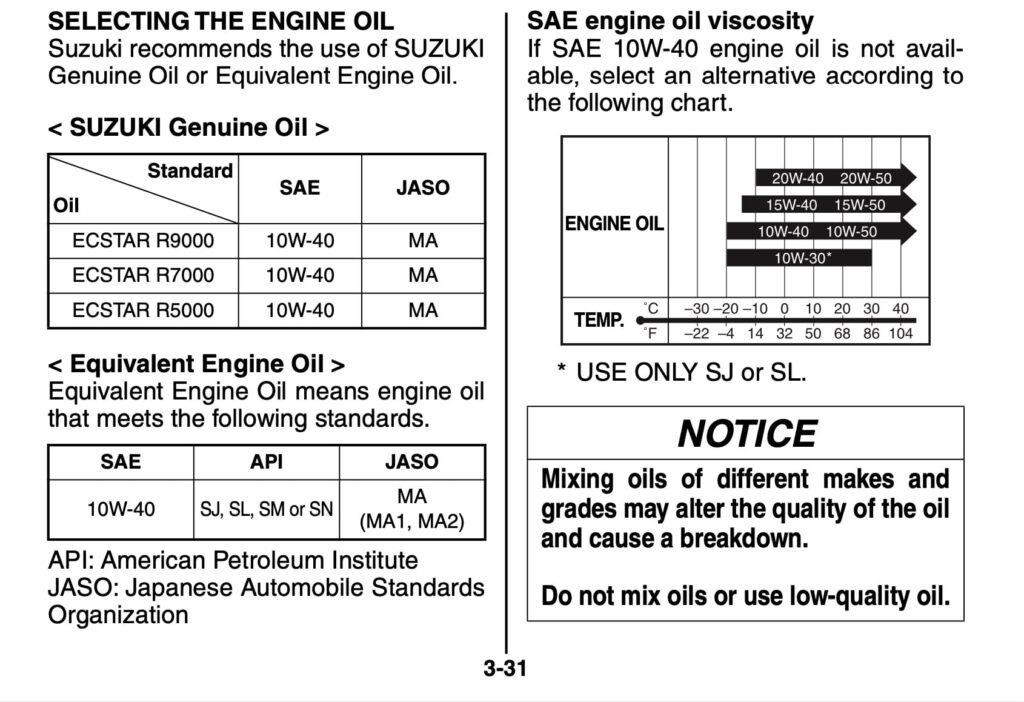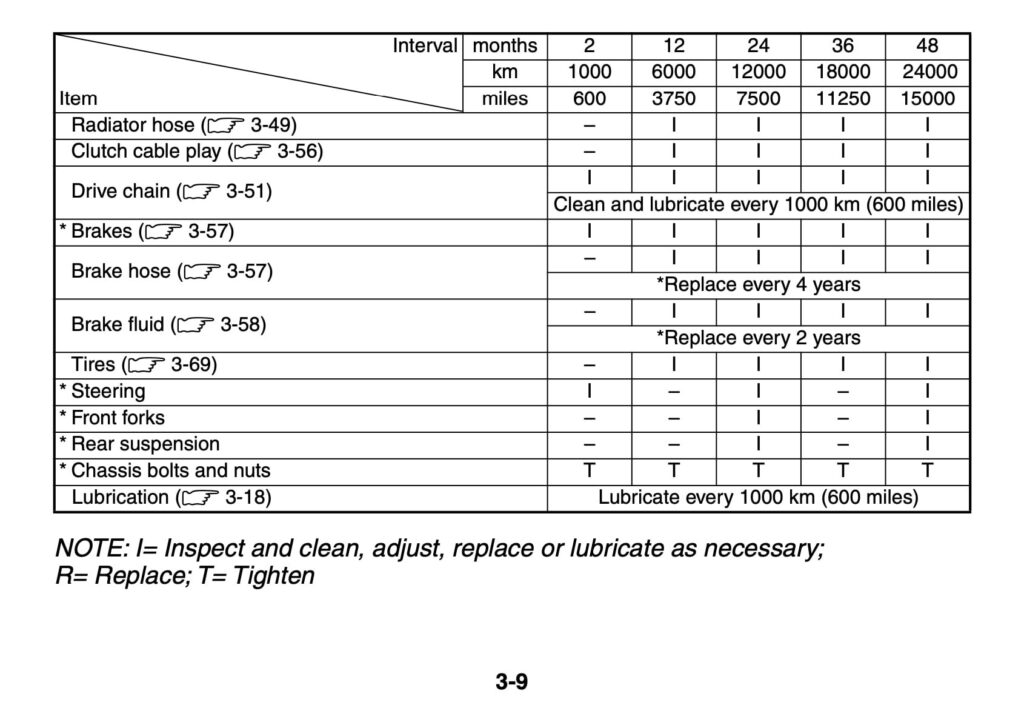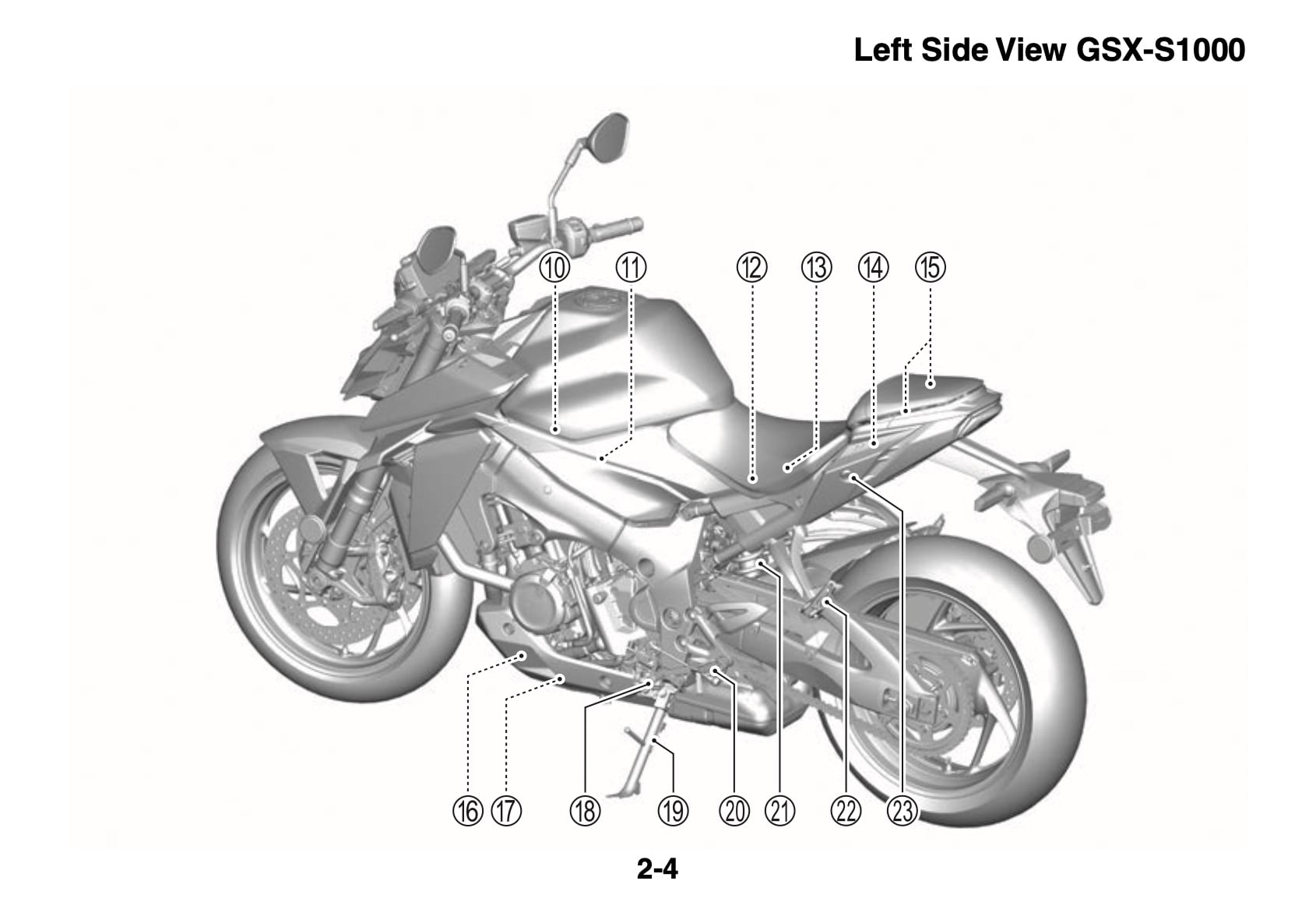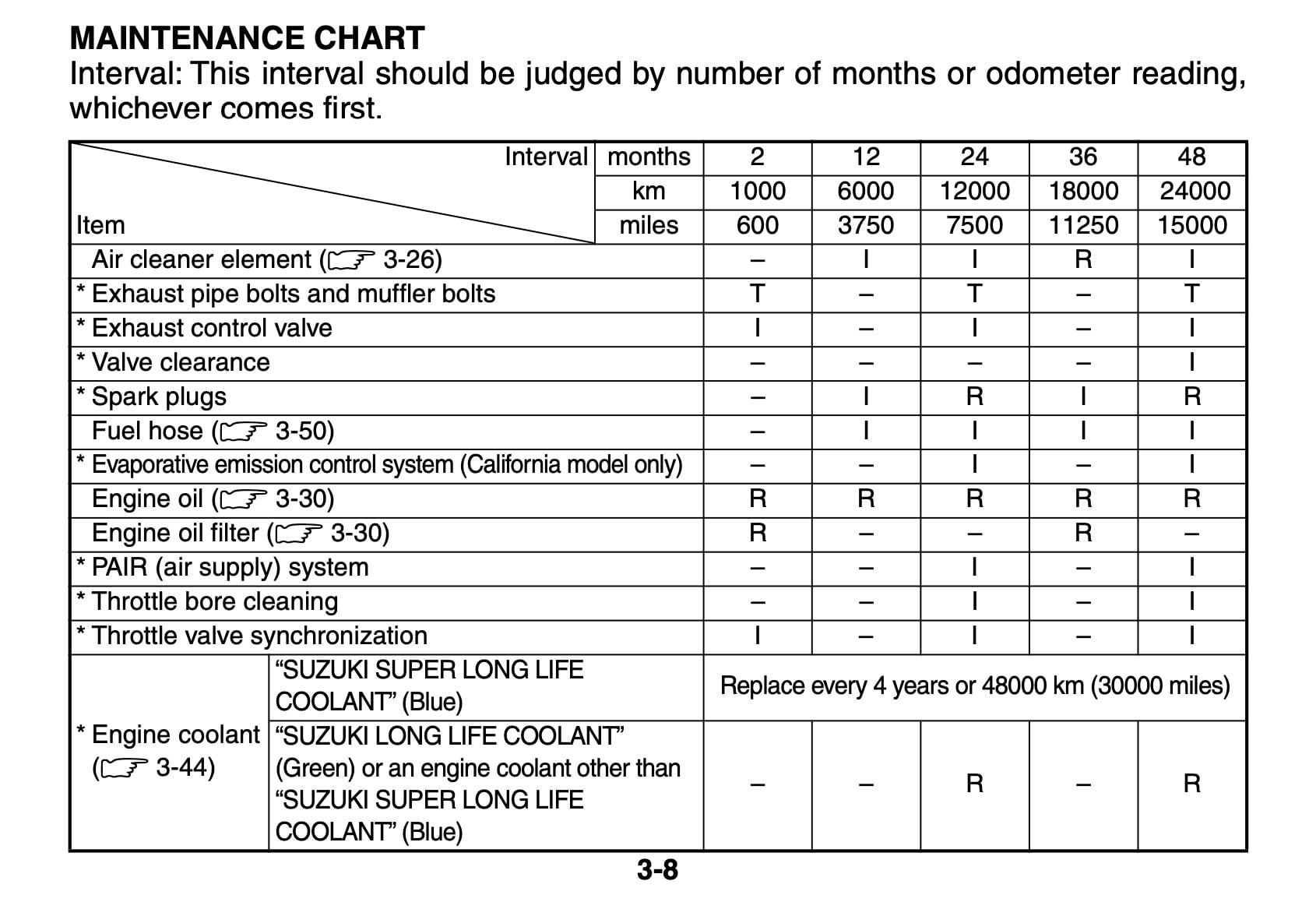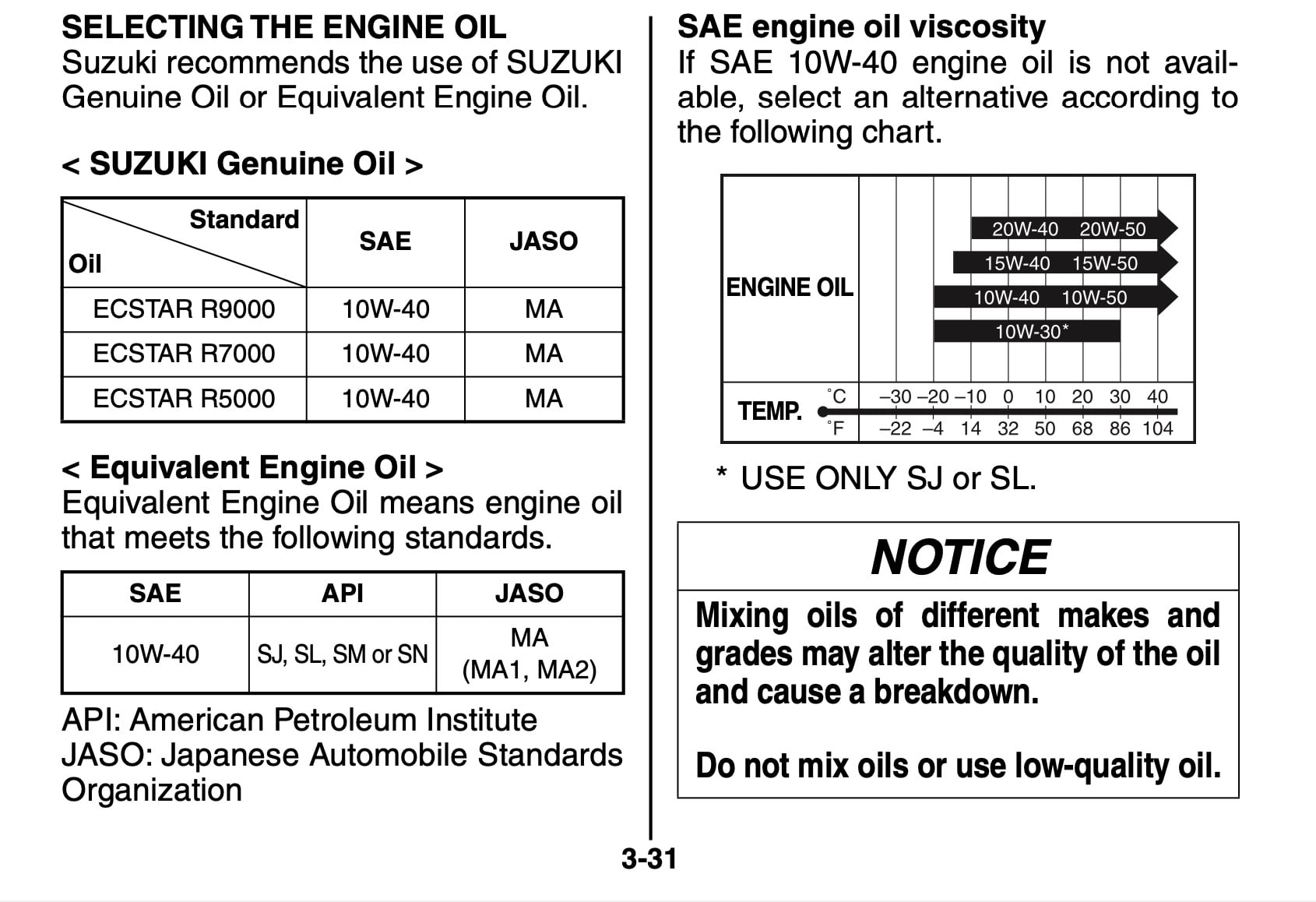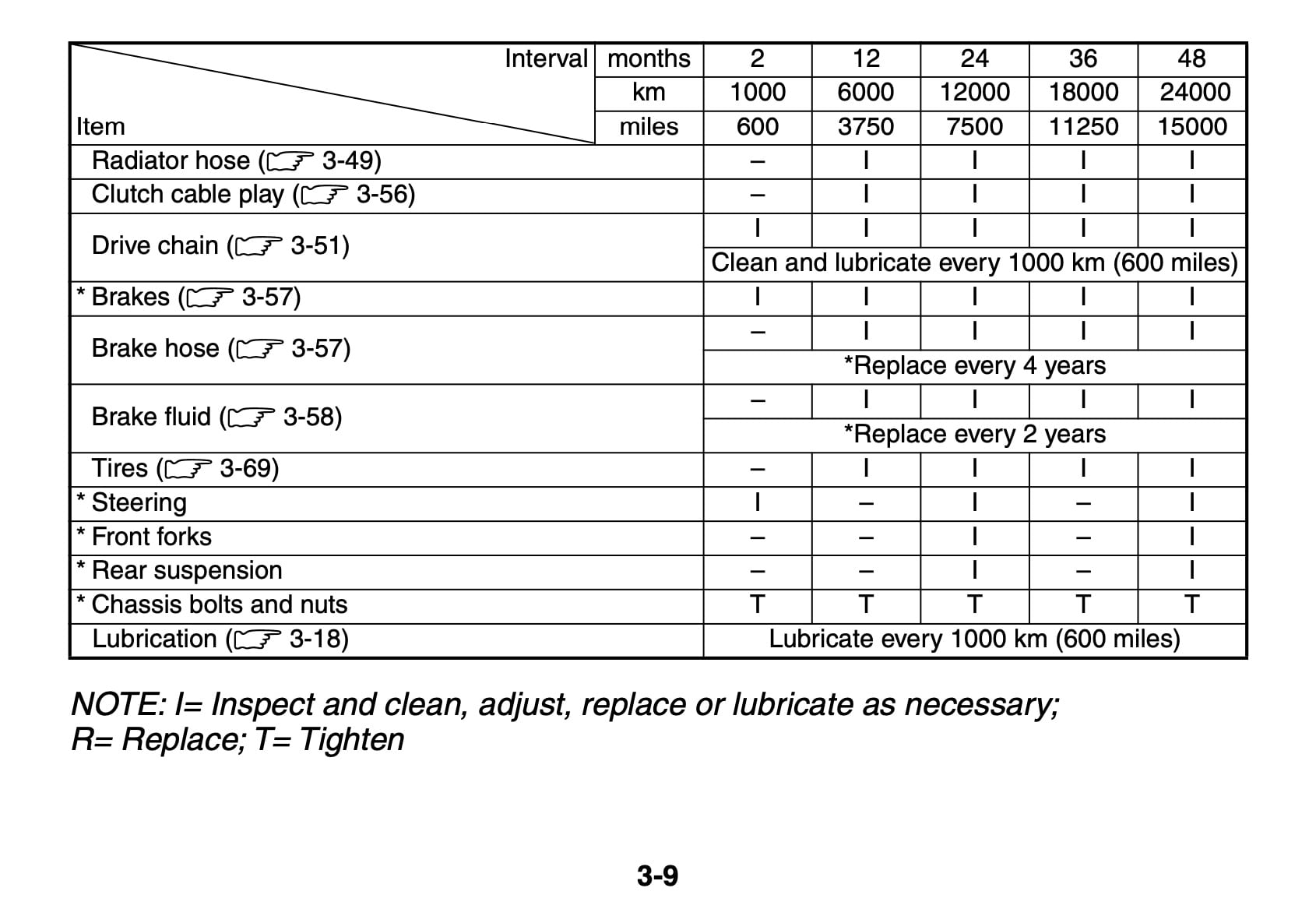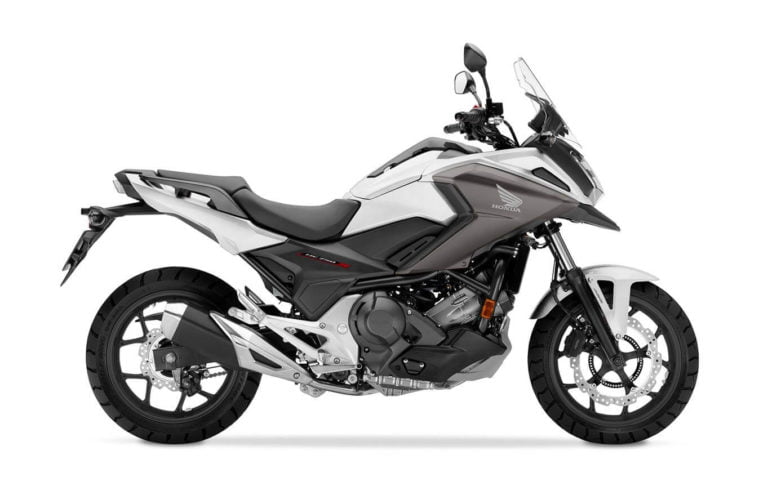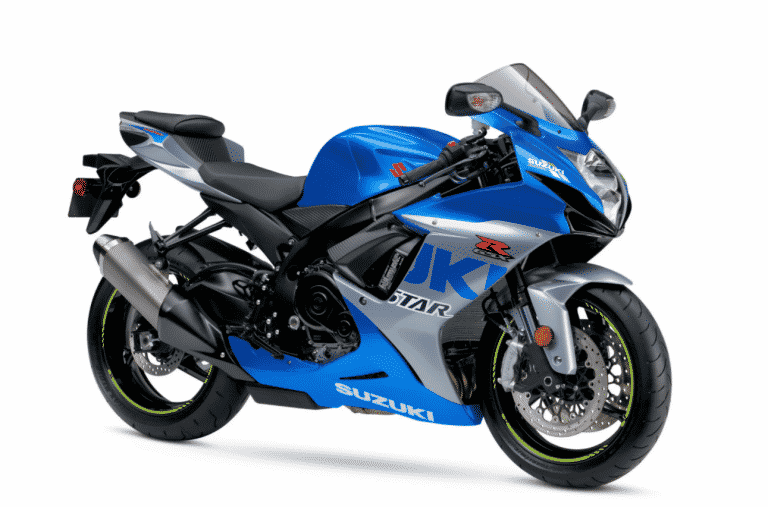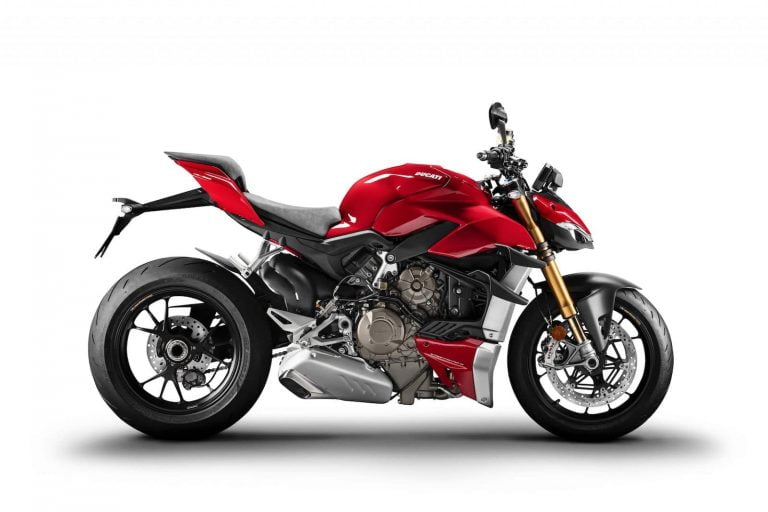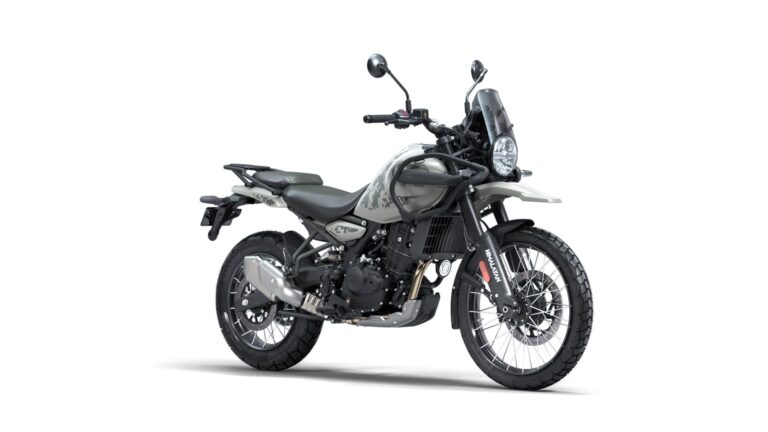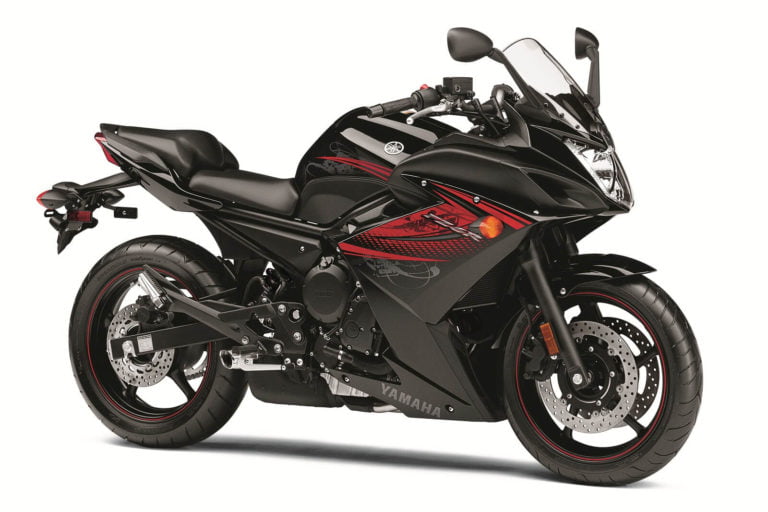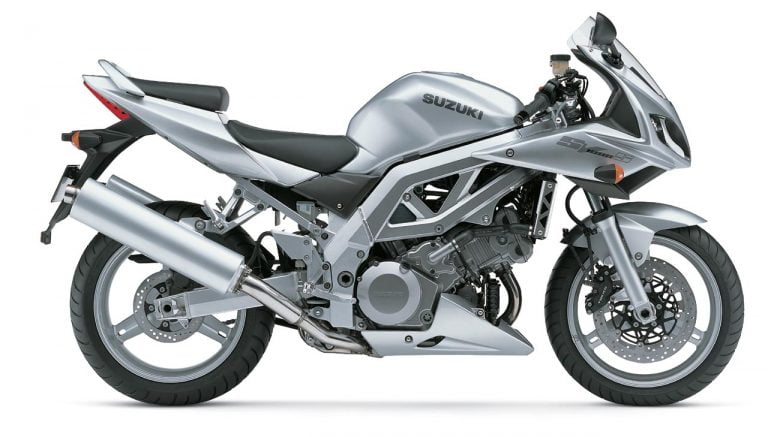Suzuki GSX-S1000 (2022+) Simplified Maintenance Schedule and Service Intervals
This is the maintenance schedule and associated service intervals for the Suzuki GSX-S1000 naked bike made from 2022 onward.
The Suzuki GSX-S1000 is a naked bike powered by Suzuki’s 999cc inline four-cylinder engine. The 2022+ model is a redesign of the Suzuki GSX-S1000 naked bike that has been produced since 2016. Suzuki went to town and gave the new bike dramatic new styling, a lightened aluminium frame, and re-tuned engine for smoother power delivery, and an improved stance.
The engine at the heart of the 2022 Suzuki GSX-S1000 is the same basic 999 cc inline four-cylinder engine that has powered the GSX-S1000 line since its inception. It’s a re-purposing of the iconic block that was in the now-iconic K5 GSX-R1000, the “long stroke” motor with a broad spread of torque that leaves old-school bikers pining for the good-old days.
The GSX-S1000 is also released along with a refreshed 2022+ GSX-S1000GT fully faired sport touring bike.
This site has links for things like oil and spark plugs from which we earn a commission (which unfortunately nobody can save, not even us). If you appreciate this work, then please use those links. Thanks!
Suzuki GSX-S1000 (2022) Service Intervals
Your first service on the GSX-S is at 600 miles or 1000 km, or 2 months — this is the break in service. The dealer should change the oil and filter and look everything over.
Following that, basic service intervals for the new Suzuki GSX-S1000 are every 3750 miles or 6000 km, at which point you should change the oil and inspect or replace the spark plugs as well as the air filter.
The valve service is every 15000 miles or 24000 km.
The GSX-S1000 has a cable clutch but hydraulic brakes, so make sure you change the brake fluid periodically. Also make sure the coolant is fresh using the appropriate spec coolant (Suzuki Long-Life, preferably).
Suzuki also recommends you lubricate external parts every 600 miles / 1000 km, which you can do along with the chain maintenance for convenience.
What you need to service your Suzuki GSX-S1000 (2022)
Below is a list of the things you’ll need to do a service on your Suzuki GSX-S1000 naked bike (2022+ model).
| Part | Suzuki GSX-S1000 spec |
|---|---|
| Oil | Suzuki (like most motorcycle brands) requires engine oil with JASO MA spec, or at least API SF/SG or SH/SJ spec. Many oils fit this. Suzuki recommends SAE 10W-40 Suzuki motor oil, but you can also use another popular high-grade oil like Motul 7100 10W-40. |
| Oil filter | Use a Hiflofiltro HF138RC, a drop-in high-quality replacement. |
| Air filter | Use a high-performance DNA air filter as a drop-in replacement, part number P-S10GT22-01. |
| Spark plugs | The standard spark plug is NGK CR9EIA9, an iridium plug. You need four. |
| Brake fluid | Suzuki (like most motorcycles) requires DOT 4 brake fluid, e.g. Castrol DOT 4. |
| Brake pads | Most people upgrade their brake pads to EBC ones for better performance (and they’re very affordable). Use EBC part codes FA447HH for the front (two pairs) and FA174HH for the rear (one pair). |
| Coolant | Suzuki recommends using “Suzuki super long life coolant“, or another ethylene glycol-based antifreeze compatible with an aluminium radiator. Use Motorex Coolant M3.0 or another alternative. |
| Chain maintenance | Use either Motul chain paste or a complete Motul chain care kit for frequent chain servicing. |
| Grease | Always handy to have some lithium soap-based grease for external pivot points, like the kickstand. |
Suzuki GSX-S1000 Maintenance Schedule
Below is the maintenance schedule for the 2022+ Suzuki GSX-S1000.
Notes:
- Observe the first of the distance or time intervals.
- Coolant — If using super long-life kind, replace every four years or 48000 km; otherwise, replace every two years or 24000 km.
| mi x 1000 | 0.6 | 3.75 | 7.5 | 11.25 | 15 | |
|---|---|---|---|---|---|---|
| km x 1000 | 1 | 6 | 12 | 18 | 24 | |
| Months | 2 | 12 | 24 | 36 | 48 | Every |
| Engine oil — Replace (High-grade synthetic, Motul 7100 10W-40) | ✓ | ✓ | ✓ | ✓ | ✓ | |
| Engine oil filter — Replace (HF138RC) | ✓ | ✓ | ||||
| Spark plugs — (I)nspect / (R)eplace (CR9EIA9) | I | R | I | R | ||
| Valve clearance — Inspect | ✓ | |||||
| Air filter — (I)nspect / (R)eplace (DNA P-S10GT22-01) | I | I | R | I | ||
| Brakes — Check function | ||||||
| Brake fluid — (I)nspect / Replace (Castrol DOT 4) Level in front and rear reservoirs should be above minimum | I | I | I | I | Replace every 2 years | |
| Brake hoses — (I)nspect routing / Replace | I | I | I | I | Replace every 4 years | |
| Radiator hose — Inspect condition, and for leaks | ✓ | ✓ | ✓ | ✓ | ||
| Engine coolant — Replace (“Super Long Life”, e.g. Motorex M3.0 Coolant) | 4 years or 48K km (29K miles) | |||||
| Throttle valve synchronization — Inspect / Adjust | ✓ | ✓ | ✓ | |||
| Throttle bore — Clean | ✓ | ✓ | ||||
| Clutch cable play — Adjust Target play: 10-15 mm / 0.4-0.6 in measured at end of clutch lever | ✓ | ✓ | ✓ | ✓ | ||
| Fuel hoses — Inspect for wear / cracks | ✓ | ✓ | ✓ | ✓ | ||
| Steering — Inspect for smooth operation | ✓ | ✓ | ✓ | |||
| Front forks — Inspect for smooth operation, leaks | ✓ | ✓ | ||||
| Rear suspension — Inspect for smooth operation, leaks | ✓ | ✓ | ||||
| Exhaust pipe bolts and muffler bolts — Tighten | ✓ | ✓ | ✓ | |||
| PAIR (air supply) system — Inspect | ✓ | ✓ | ||||
| Evaporative emission control system (if fitted) — Check | ✓ | ✓ | ||||
| Exhaust control valve — Inspect | ✓ | ✓ | ✓ | |||
| Tires — Inspect condition and tread | ✓ | ✓ | ✓ | ✓ | ||
| General lubrication — Perform | ✓ | ✓ | ✓ | ✓ | ✓ | 1000 km / 600 mi |
| Chassis bolts and nuts — Tighten | ✓ | ✓ | ✓ | ✓ | ✓ |
Maintaining the Chain on your Suzuki GSX-S1000
Maintain your GSX-S’ chain regularly according to the following schedule. Either use a good-quality (and affordable) chain lube like Motul Chain Paste, or use a full on Motul Chain Care Kit to clean and restore a chain.
Suzuki recommends that you maintain your chain regularly according to the following schedule.
| Chain maintenance item | Every |
|---|---|
| Check chain * Correct tension / slack (20-30mm / 0.8-1.2 in at loosest point) * Adequate lubrication * No excessive wear / damage | Ride (pre-ride check) |
| Clean and lubricate chain | 1000 km / 600 miles |
Damage includes loose pins, damaged rollers, dry or rusted links, kinked or binding links, excessive wear, and improper adjustment.
Checking Chain Slack
To check the slack on the Suzuki GSX-S1000, put the bike in neutral, onto its kickstand, and on a level surface.
Check the slack on the lower part of the chain, midway between the sprockets, and check it in multiple places (move the motorcycle forwards and backwards) as chains wear unevenly.
Slack on the GSX-S1000 is defined as the free vertical movement of the chain.
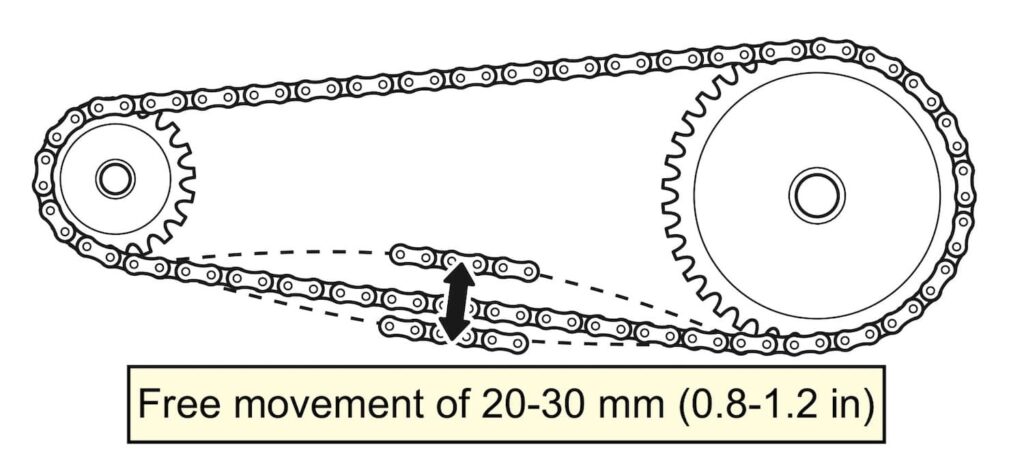
Target chain slack for the Suzuki GSX-S1000: 20 – 30 mm (0.8 – 1.2 in)
If the chain slack is out of spec, you need to adjust it.
Adjusting chain slack
To adjust the chain slack on the Suzuki GSX-S1000, follow the below procedure. As with most conventional sport bikes, the procedure is simple, as long as you have the area to do it.
As when measuring chain slack, make sure that the motorcycle is on a level surface, on its kickstand, in neutral, with no weight on it (no saddlebags, if you have any fitted).
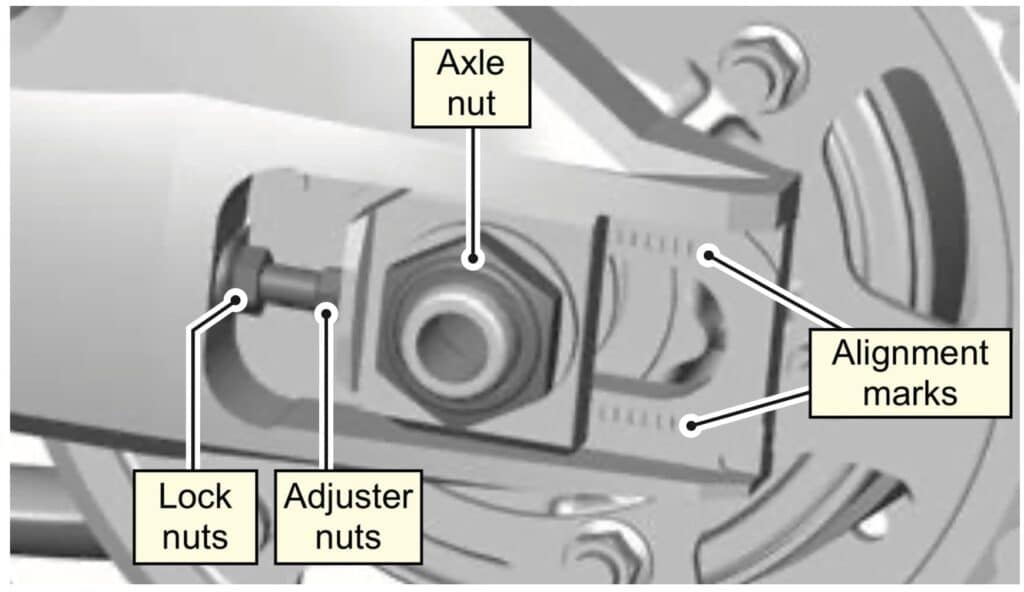
- Loosen the rear axle with a breaker bar. Also loosen the adjuster lock nuts on either side of the axle.
- Turn the adjuster nuts to tighten (or loosen) the chain. Keep checking the chain tension to see if it has come within spec. Aim for the tighter end of the spec (20 mm).
- Keep an eye on the adjuster alignment marks on either side of the axle. Make sure that the adjustment of the axle is to the same point to maintain alignment.
- When you’re done, tighten the axle to 100 Nm / 74 lb-ft.
- Tighten the lock nuts to 22 Nm / 17 lb-ft.
- Re-check the chain slack again to make sure it’s still within spec.
Tire size and tire pressure for the Suzuki GSX-S1000
The manual for the GSX-S1000 specifies the following tire sizes and pressures.
The GSX-S1000 Naked ships with Dunlop Roadsport 2 tire, just as its sibling the GT does.
| Tyre | Size | Tyre pressure (cold) |
|---|---|---|
| Front | 120/70 ZR17 58W | 36 psi / 250 kPa / 2.5 bar |
| Rear | 190/50ZR17 73W | 42 psi / 290 kPa / 2.9 bar |
About the Suzuki GSX-S1000 (2022+)
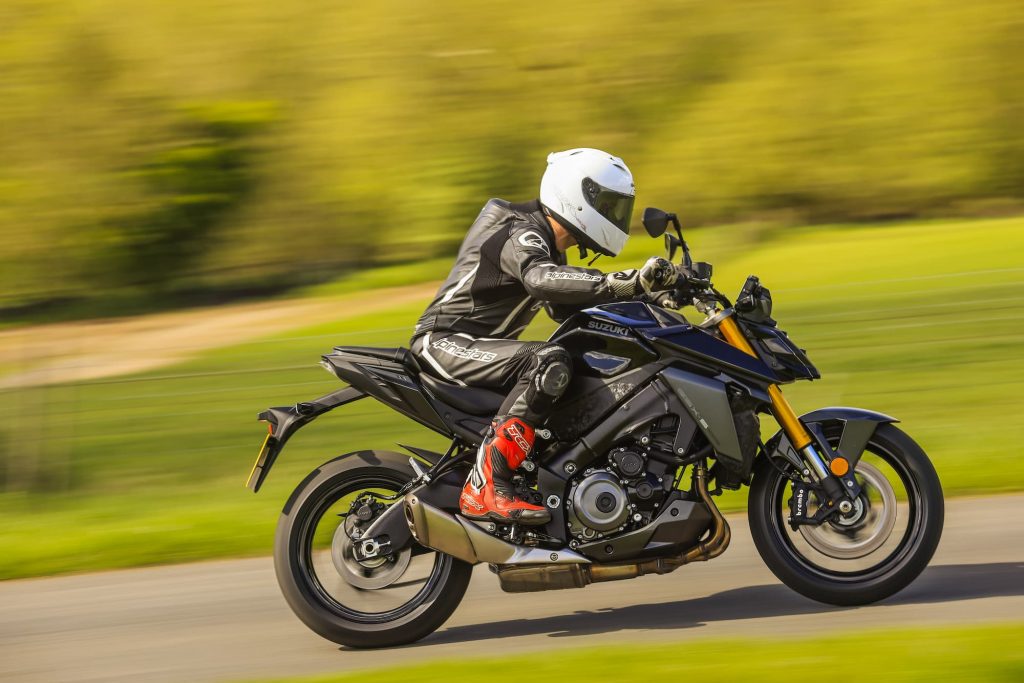
The 2022 Suzuki GSX-S1000 may have a long name full of letters and numbers, but it’s actually quite a simple bike compared to some of its brethren.
At its core, it’s the same concept as its predecessor — a naked superbike with an engine tuned for torque. The engine is the 999 cc inline four-cylinder engine that has history dating back to the 2005-2008 Suzuki GSX-R1000, whose engine (at least in 2005-2006 guise) was lauded for its broad spread of torque. Later GSX-Rs became higher power but more peaky in their delivery.
The original GSX-S1000 was a little lumpy in its power delivery. But Suzuki has fixed that, tuning away the peaks and troughs into a smooth torque curve that is what the GSX-S should have been all along.
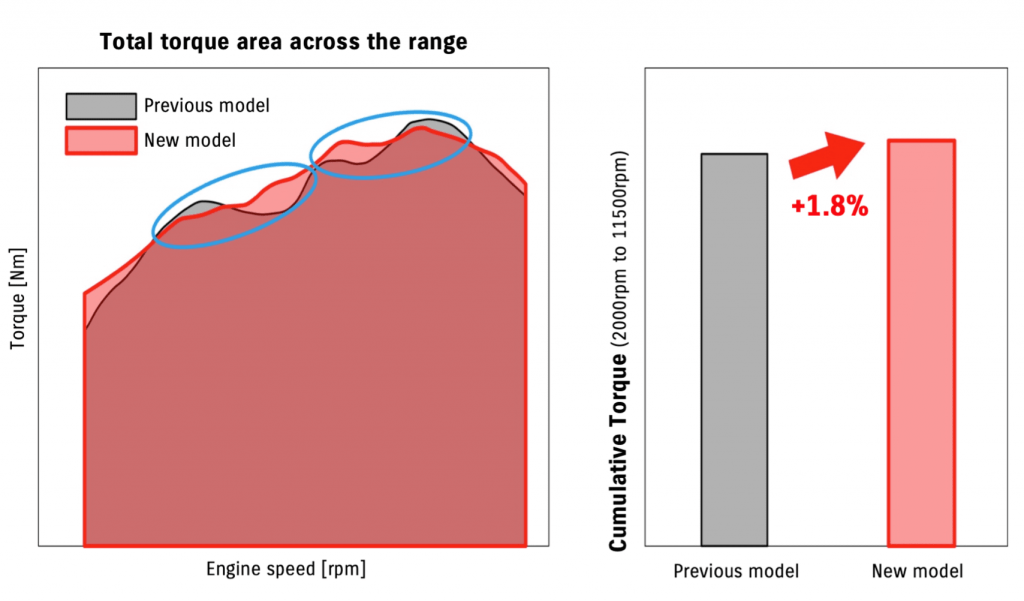
The engine makes peak power of 150 bhp (152 PS / 112 kW) at 11000 rpm and peak torque of 78 ft-lb (106 Nm) at 9250 rpm. But what’s more impressive is that the torque is smoothed out so that there’s much more torque at low RPM, as well as more torque overall (what they call “cumulative torque”, describing the area under the torque curve).
But before you even get onto the bike, the first thing you notice is that the Suzuki GSX-S1000’s image has changed dramatically. The new vertically-stacked headlights are definitely a much more modern and aggressive streetfighter design than what we saw on the previous gen.
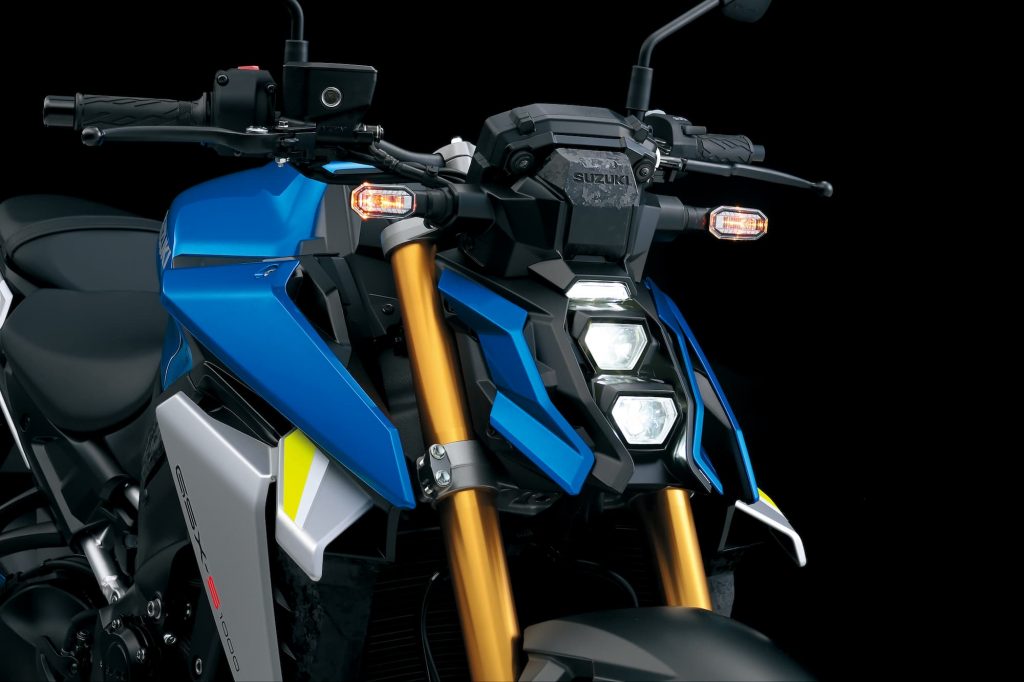
While it might be a bit too aggressive for some people, the headlight setup will please those who don’t like the asymmetrical look that the GSX-S1000GT has, where in normal running conditions only one of the two lights is illuminated.
Suzuki also added ride-by-wire to the new GSX-S1000. This means there’s no longer a throttle cable to lubricate. However, unfortunately, the naked bike doesn’t get the cruise control system of its faired sibling. You might be able to plug in the controller from that model, though…
The Suzuki GSX-S1000 also gets a TFT display, bi-redictional quickshifter, and some LED lighting.
The GSX-S1000’s brakes are twin 310mm calipers with Brembo radial-mount monoblock calipers, each with four 32mm pistons. The brakes have ABS, but no cornering function (normally provided by an IMU).
Suspension is the same competent but relatively simple setup — fully adjustable KYB front forks and a rear monoshock that’s also adjustable.
Reference Manual for the Suzuki GSX-S1000
The above maintenance schedule comes directly from the user’s manual for the 2022 Suzuki GSX-S1000. It’s similar to the maintenance schedule for the GSX-S1000 for previous years, other than changes due to ride-by-wire.
Below are screenshots from the manual for reference.
You can download manuals for Suzuki motorcycles from here.
